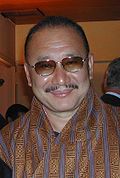Bhutanese National Assembly election, 2008
|
|
|||||||||||||||||||||||||
|---|---|---|---|---|---|---|---|---|---|---|---|---|---|---|---|---|---|---|---|---|---|---|---|---|---|
|
|||||||||||||||||||||||||
|
All 47 seats to the National Assembly |
|||||||||||||||||||||||||
|
|||||||||||||||||||||||||

Results of the Bhutanese Elections.
|
|||||||||||||||||||||||||
|
|||||||||||||||||||||||||
National Assembly elections were held in Bhutan for the first time on 24 March 2008. Two parties were registered by the Election Commission of Bhutan to contest the election: the Bhutan Peace and Prosperity Party (DPT, for Druk Phuensum Tshogpa), which was formed by the merger of the previously established Bhutan People's United Party and All People's Party and is led by Jigme Y. Thinley, and the People's Democratic Party (PDP). The third political party, the Bhutan National Party (BNP), had its application for the registration canceled.
The elections for the 47 seats of the National Assembly were planned to be held in two rounds: In the first round, voters would have voted for a party. The two parties with the largest share of the national vote would then have been able to field candidates in the 47 constituencies. However, as only two parties successfully registered for the election, the election was held in one round.
On 21 April 2007, a mock election was held to prepare the population of Bhutan for the imminent change to democracy. These elections were held in all 47 National Assembly constituencies and at 869 polling stations with around 1,000 voters at each one of them. The parties "contesting" the election were the Druk Blue Party, the Druk Green Party, the Druk Red Party and the Druk Yellow Party (with Druk being dzongkha for "thunder dragon"), each of them representing certain values as their "party manifesto": yellow for traditional values, red for industrial development, blue for fairness and accountability, and green for the environment. The two parties winning the most votes were to proceed to a run-off election scheduled for 28 May. Election observers were present from the United Nations and from India.
...
Wikipedia

